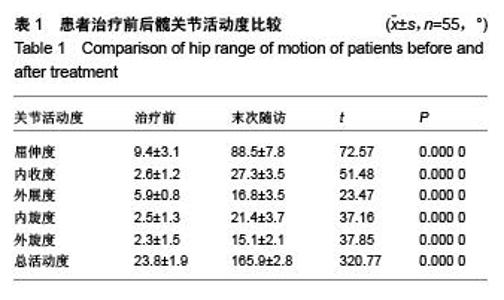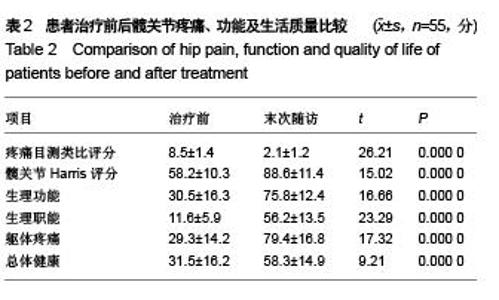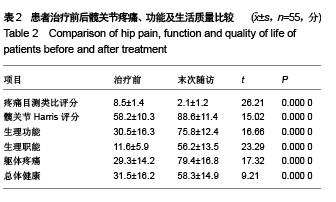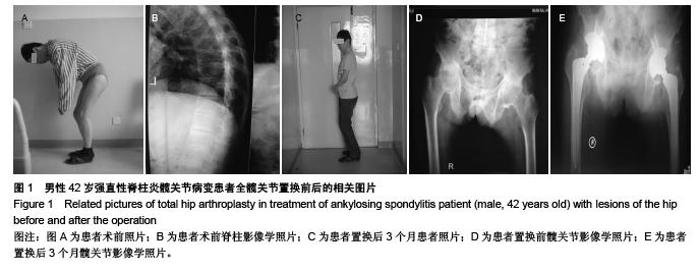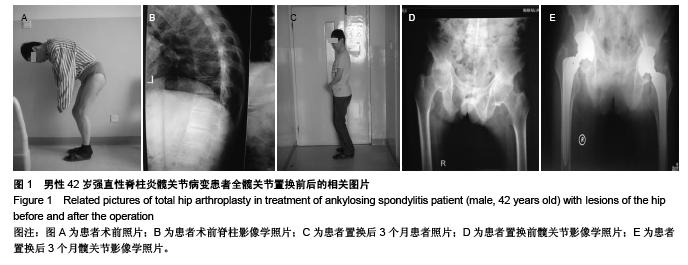Chinese Journal of Tissue Engineering Research ›› 2015, Vol. 19 ›› Issue (53): 8549-8553.doi: 10.3969/j.issn.2095-4344.2015.53.004
Previous Articles Next Articles
Total hip arthroplasty repairs ankylosing spondylitis-associated hip joint lesion based on the biological level: 2-year follow-up
Ding Liang-jia1, Liu Ying-li2, Liu Xiao-min1, Ma Gang1, Liu Chang-lu1
- 1Department of Joint Surgery, 2Department of Rehabilitation, the Second Affiliated Hospital of Inner Mongolia Medical University, Hohhot 010030, Inner Mongelia Autonomous Region, China
-
Received:2015-10-01Online:2015-12-24Published:2015-12-24 -
Contact:Liu Ying-li, Department of Rehabilitation, the Second Affiliated Hospital of Inner Mongolia Medical University, Hohhot 010030, Inner Mongelia Autonomous Region, China -
About author:Ding Liang-jia, Master, Attending physician, Department of Joint Surgery, the Second Affiliated Hospital of Inner Mongolia Medical University, Hohhot 010030, Inner Mongelia Autonomous Region, China
CLC Number:
Cite this article
Ding Liang-jia, Liu Ying-li, Liu Xiao-min, Ma Gang, Liu Chang-lu. Total hip arthroplasty repairs ankylosing spondylitis-associated hip joint lesion based on the biological level: 2-year follow-up[J]. Chinese Journal of Tissue Engineering Research, 2015, 19(53): 8549-8553.
share this article
| [1] 伏海平,黄晓东,刘华兴,等.全髋关节置换治疗强直性脊柱炎髋关节强直[J].临床骨科杂志,2012,15(5):519-521.[2] 刘亮,张星火,于振山,等.人工全髋关节置换术治疗强直性脊柱炎髋关节病变的临床疗效[J].中国现代手术学杂志,2012,16(2): 130-132.[3] 高益,王斌,谢子康,等.全髋关节置换修复强直性脊柱炎:脊柱-骨盆矢状面平衡及生活质量变化[J].中国组织工程研究,2015, 18(4):516-521.[4] Xu L, Sun QW, Jiang SM, et al.Changes in gene expression profiles of the hip joint ligament of patients with ankylosing spondylitis revealed by DNA chip. Clin Rheumatol. 2012; 31(10):1479-1491.[5] 万修阳,王燕,王开友,等.人工髋关节置换术治疗强直性脊柱炎后期髋臼内陷症[J].临床外科杂志,2012,20(12):876-878.[6] 赵瑞林.全髋置换治疗强直性脊柱炎髋关节强直[J].实用骨科杂志,2012,18(6):548-549.[7] 吴超群,冯琼华.全髋置换术治疗强直性脊柱炎致髋关节强直[J].临床骨科杂志,2012,15(2):221.[8] Wang J, Zhang Y, Zhao L, et al. The efficacy and safety of infliximab used in patients with ankylosing spondylitis after unilateral total hip arthroplasty. Hip Int. 2013;23(4): 406-410.[9] 刘勇,王业华,蒋健,等.全髋关节置换术治疗强直性脊柱炎髋关节病变[J].实用骨科杂志,2014,18(9):780-784.[10] 宾永焰,田乃宜,郭义城,等.全髋关节置换治疗28例髋关节强直的临床体会[J].临床军医杂志,2013,41(11):1181-1182.[11] 高广庭,潘士虎,吕占辉,等.全髋关节置换术治疗强直性脊柱炎髋关节强直患者的并发症以及预后探讨[J].中国医师进修杂志, 2014,37(14):19-21.[12] 裴飞舟.全髋关节置换术治疗强直性脊柱炎的临床研究[J].中国社区医师,2015,12(13):46-47.[13] 李大河,徐卫东.全髋关节置换术治疗强直性脊柱炎的临床问题及研究进展[J].中华关节外科杂志(电子版),2012,6(4):605-611.[14] 王俊江.强直性脊柱炎全髋关节置换术临床治疗分析[J].中国现代药物应用,2015,9(3):67-68.[15] 王荣强.强直性脊柱炎全髋关节置换术临床治疗分析[J].中国实用医药,2014,16(15):92-93,94.[16] 汪群,隋福革,李恒,等.人工全髋关节置换术治疗强脊炎髋关节强直[J].中国伤残医学,2014,19(6):65-66.[17] 秦建英,陈清汉.强直性脊柱炎I期双侧人工全髋关节置换术[J].河南外科学杂志,2012,18(3):20-22.[18] Yilmaz O, Tutolu A, Garip Y, et al. Health-related quality of life in Turkish patients with Ankylosing spondylitis: Impact of peripheral involvement on quality of life in terms of disease activity, functional status, severity of pain, and social and emotional functioning. Rheumatol Int. 2013;33(5):1159-1163.[19] 鲍海星,严清,孙俊,等.大直径(36 mm)股骨头陶瓷对陶瓷全髋关节置换治疗终末期髋关节病的临床应用[J].安徽医药,2014, 32(12):2312-2314.[20] 马志翔,尹宗生,许鹏飞,等.合肥地区人工髋关节置换病因及相关因素:6年5所医院3056例回顾性分析[J].中国组织工程研究, 2015,36(9):1352-1357.[21] 张辉,冯国英,王心宽,等.陶瓷-陶瓷全髋关节置换术的疗效及临床体会[J].中国医刊,2014,18(7):73-74.[22] 武豪杰.髋臼缺损畸形的人工髋关节置换手术疗效分析[J].中国继续医学教育,2015,12(17):99-100,101.[23] 翟伟韬,徐岳林,丁盛,等.单侧半骨盆切除患者对侧全髋关节置换及翻修1例[J].中国骨与关节外科,2013,6(1):71-72,67.[24] 徐志宏,陈东阳,史冬泉,等.OCM入路微创小切口全髋关节置换术后的深静脉血栓发生率[J].中国骨与关节外科,2014,22(3): 183-187.[25] 吕波,王跃,朱建辛,等.全髋置换术中髋臼内陷的处理[J].实用骨科杂志,2014,14(8):701-703,768.[26] 高伟达.全髋关节置换治疗强直性脊柱炎髋关节强直效果观察[J].中国继续医学教育,2015,7(23):112-113.[27] 白云鹤,吴若丹,姚鹏举,等.强直性脊柱炎临床实施人工全髋关节置换术的临床治疗研究[J].延边医学,2014,15(31):78-79.[28] 胡如印,田晓滨,孙立,等.人工全髋关节置换治疗强直性脊柱炎髋关节强直畸形[J].中国组织工程研究,2012,51(44):8356-8360.[29] 于情,顾彬,戴佳文,等.全髋关节置换术在强直性脊柱炎的应用分析[J].重庆医学,2014,18(6):733-734. |
| [1] | Chen Ziyang, Pu Rui, Deng Shuang, Yuan Lingyan. Regulatory effect of exosomes on exercise-mediated insulin resistance diseases [J]. Chinese Journal of Tissue Engineering Research, 2021, 25(25): 4089-4094. |
| [2] | Chen Yang, Huang Denggao, Gao Yuanhui, Wang Shunlan, Cao Hui, Zheng Linlin, He Haowei, Luo Siqin, Xiao Jingchuan, Zhang Yingai, Zhang Shufang. Low-intensity pulsed ultrasound promotes the proliferation and adhesion of human adipose-derived mesenchymal stem cells [J]. Chinese Journal of Tissue Engineering Research, 2021, 25(25): 3949-3955. |
| [3] | Yang Junhui, Luo Jinli, Yuan Xiaoping. Effects of human growth hormone on proliferation and osteogenic differentiation of human periodontal ligament stem cells [J]. Chinese Journal of Tissue Engineering Research, 2021, 25(25): 3956-3961. |
| [4] | Sun Jianwei, Yang Xinming, Zhang Ying. Effect of montelukast combined with bone marrow mesenchymal stem cell transplantation on spinal cord injury in rat models [J]. Chinese Journal of Tissue Engineering Research, 2021, 25(25): 3962-3969. |
| [5] | Gao Shan, Huang Dongjing, Hong Haiman, Jia Jingqiao, Meng Fei. Comparison on the curative effect of human placenta-derived mesenchymal stem cells and induced islet-like cells in gestational diabetes mellitus rats [J]. Chinese Journal of Tissue Engineering Research, 2021, 25(25): 3981-3987. |
| [6] | Hao Xiaona, Zhang Yingjie, Li Yuyun, Xu Tao. Bone marrow mesenchymal stem cells overexpressing prolyl oligopeptidase on the repair of liver fibrosis in rat models [J]. Chinese Journal of Tissue Engineering Research, 2021, 25(25): 3988-3993. |
| [7] | Liu Jianyou, Jia Zhongwei, Niu Jiawei, Cao Xinjie, Zhang Dong, Wei Jie. A new method for measuring the anteversion angle of the femoral neck by constructing the three-dimensional digital model of the femur [J]. Chinese Journal of Tissue Engineering Research, 2021, 25(24): 3779-3783. |
| [8] | Meng Lingjie, Qian Hui, Sheng Xiaolei, Lu Jianfeng, Huang Jianping, Qi Liangang, Liu Zongbao. Application of three-dimensional printing technology combined with bone cement in minimally invasive treatment of the collapsed Sanders III type of calcaneal fractures [J]. Chinese Journal of Tissue Engineering Research, 2021, 25(24): 3784-3789. |
| [9] | Qian Xuankun, Huang Hefei, Wu Chengcong, Liu Keting, Ou Hua, Zhang Jinpeng, Ren Jing, Wan Jianshan. Computer-assisted navigation combined with minimally invasive transforaminal lumbar interbody fusion for lumbar spondylolisthesis [J]. Chinese Journal of Tissue Engineering Research, 2021, 25(24): 3790-3795. |
| [10] | Hu Jing, Xiang Yang, Ye Chuan, Han Ziji. Three-dimensional printing assisted screw placement and freehand pedicle screw fixation in the treatment of thoracolumbar fractures: 1-year follow-up [J]. Chinese Journal of Tissue Engineering Research, 2021, 25(24): 3804-3809. |
| [11] | Shu Qihang, Liao Yijia, Xue Jingbo, Yan Yiguo, Wang Cheng. Three-dimensional finite element analysis of a new three-dimensional printed porous fusion cage for cervical vertebra [J]. Chinese Journal of Tissue Engineering Research, 2021, 25(24): 3810-3815. |
| [12] | Wang Yihan, Li Yang, Zhang Ling, Zhang Rui, Xu Ruida, Han Xiaofeng, Cheng Guangqi, Wang Weil. Application of three-dimensional visualization technology for digital orthopedics in the reduction and fixation of intertrochanteric fracture [J]. Chinese Journal of Tissue Engineering Research, 2021, 25(24): 3816-3820. |
| [13] | Sun Maji, Wang Qiuan, Zhang Xingchen, Guo Chong, Yuan Feng, Guo Kaijin. Development and biomechanical analysis of a new anterior cervical pedicle screw fixation system [J]. Chinese Journal of Tissue Engineering Research, 2021, 25(24): 3821-3825. |
| [14] | Lin Wang, Wang Yingying, Guo Weizhong, Yuan Cuihua, Xu Shenggui, Zhang Shenshen, Lin Chengshou. Adopting expanded lateral approach to enhance the mechanical stability and knee function for treating posterolateral column fracture of tibial plateau [J]. Chinese Journal of Tissue Engineering Research, 2021, 25(24): 3826-3827. |
| [15] | Zhu Yun, Chen Yu, Qiu Hao, Liu Dun, Jin Guorong, Chen Shimou, Weng Zheng. Finite element analysis for treatment of osteoporotic femoral fracture with far cortical locking screw [J]. Chinese Journal of Tissue Engineering Research, 2021, 25(24): 3832-3837. |
| Viewed | ||||||
|
Full text |
|
|||||
|
Abstract |
|
|||||
